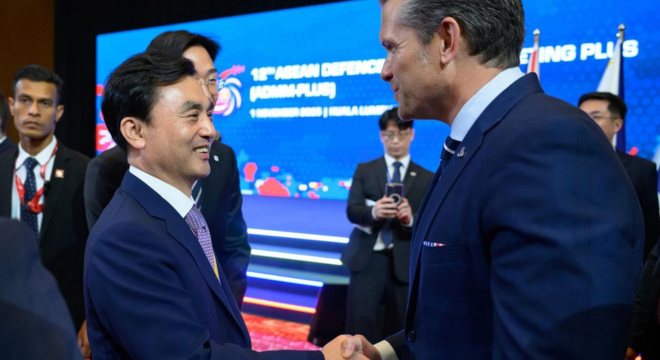What happens when two powerful allies — bound by history, divided by strategy — come face to face at one of the world’s most tense borders?
That’s exactly what the world is watching right now at the South Korea US Defense Talks 2025, as South Korean Defense Minister Ahn Gyu-back and U.S. Defense Secretary Pete Hegseth meet at the Joint Security Area (Panmunjeom) — the narrow line that separates North and South Korea.
But wait — why is this visit so important?
Why are the defense chiefs standing together after eight years?
And what does it mean for the future of the South Korea-US alliance?
Let’s start from the beginning.
The Big Picture: A Historic Meeting at the Border
It’s November 2025, and the atmosphere around the Korean Peninsula is heavier than usual. North Korea keeps flexing its military muscles, China is pushing for more control in the region, and the Trump administration in the U.S. is talking tough on defense partnerships.
In the middle of all this, Pete Hegseth lands in Seoul for a two-day visit. His first stop? The Joint Security Area (JSA) — the small but symbolic patch of land where soldiers from both Koreas stand just meters apart.
Standing beside him is Ahn Gyu-back, South Korea’s new defense minister under the Lee Jae Myung administration. Together, they’re sending a message to the world: “We stand united for peace and stability on the Korean Peninsula.”
This is the first joint visit to the DMZ in eight years — the last one happened back in 2017. So yeah, it’s a big deal.

The Purpose: Beyond Symbolism
Now, some might think this visit is just for show — a few photos, a handshake, and done.
But it’s not that simple.
Their meeting sets the stage for something much bigger — the 57th Security Consultative Meeting (SCM) in Seoul. This annual Korea-US security meeting is where both sides sit down to discuss military cooperation, regional strategy, and the future of the alliance.
This year’s SCM carries extra weight because the two countries are working on redefining how the alliance works in the modern era.
Topics on the table include:
- The South Korea OPCON transfer talks, meaning South Korea’s goal to take full wartime control of its military — something still held by the U.S. since the Korean War.
- The US Korea nuclear submarine discussion, after Trump and Lee Jae Myung agreed that Seoul can develop a nuclear-powered submarine plan to track North Korean and Chinese vessels.
- The US Forces Korea modernization, ensuring the 28,500 U.S. troops stationed in Korea remain flexible and ready for new threats in the Indo-Pacific.
The Shifting Role of the U.S. Troops
For decades, the U.S. military presence in South Korea has been about deterrence — keeping North Korea in check. But now, Washington wants to make that role more flexible.
Basically, the U.S. is considering whether its troops in Korea could respond to broader regional threats — not just from Pyongyang, but also from places like Taiwan and the South China Sea, where China’s influence is rising fast.
That’s part of the extended deterrence strategy — making sure America’s defense commitments can stretch beyond one border.
But Seoul isn’t entirely comfortable with that.
South Korea wants to ensure that U.S. troops remain focused on the Korean Peninsula, especially while North Korea continues building new missiles like the Hwasong-20.
So yeah, the Korea-US defense policy meeting isn’t just about friendship — it’s about finding balance between flexibility and focus.
The Budget, Submarines, and Big Promises
During his visit, Pete Hegseth praised South Korea for planning the largest defense budget increase in years.
That’s not random — it’s linked to President Trump’s demand that allies pay more for hosting U.S. forces.
At the same time, South Korea’s new nuclear submarine project is catching attention.
President Lee Jae Myung openly asked Trump to approve fuel access for the subs, and Trump responded by allowing construction at a Philadelphia shipyard run by Hanwha Ocean.
The goal? Strengthen South Korea’s ability to track North Korean and Chinese vessels — and lighten the load on U.S. forces.
This marks a new chapter in South Korea-US military cooperation, where Seoul is no longer just a partner — it’s becoming a powerful defense player on its own.
What the Leaders Are Saying
Pete Hegseth has called South Korea a “combat credible partner” and praised its efforts to take more responsibility for defense.
He supports the wartime operational control handover process — saying it’s a great example of a strong ally standing on its own feet.
On the other hand, Ahn Gyu-back says his government will make the “utmost effort” to complete the OPCON transfer within President Lee’s term, without weakening the alliance.
Both leaders know this: the alliance’s future depends on trust, capability, and adaptability.
Why This Matters Right Now
Look around the region — the U.S.-China rivalry is heating up.
Japan is boosting its defense spending. North Korea keeps testing missiles.
In that environment, the South Korea-US alliance meeting becomes more than a formality. It’s a message to every player in Asia that Seoul and Washington aren’t backing down.
The Camp Humphreys visit, where Hegseth meets troops, adds to that symbolism — reminding everyone that real people, not just politics, are standing guard for peace.
Even so, both parties continue to stress one particular word: peace.
Because, while military cooperation is important, the end goal is still the same — peace and stability on the Korean Peninsula.
In summary: From Photos to Policy
So stay with me cutiee, if we stitch together the threads — the Ahn Gyu-back Pete Hegseth JSA visit, the SCM, and the defense policy discussions — it all fits in one story line:
- South Korea wants more control.
- The U.S. wants more flexibility.
- Both aim to remain united against growing threats.
These meetings in 2025 will be a turning point — one where symbolism meets strategy, and promises become plans.
Because if we see two allies standing shoulder to shoulder on the world’s most dangerous border, it isn’t just for photographs. It’s to remind all the eyes on them that the states can still make peace, exert their power, and partner — even in the most divided place on Earth.


